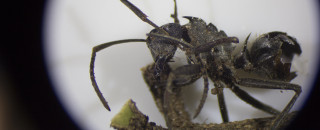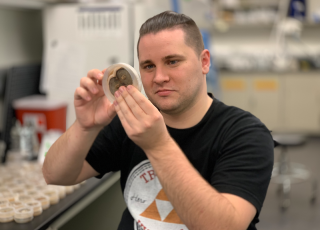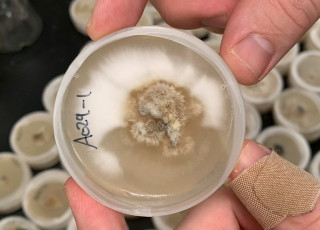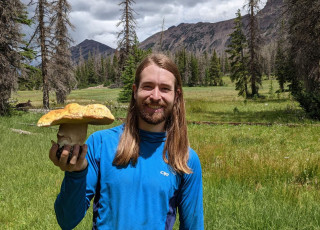Zombie Ants
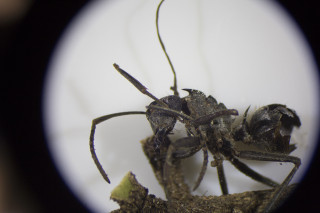
By Westin Porter
The zombie apocalypse. It's an idea we’ve all entertained. How would it happen? What would I do? What would become of the world? Is it possible, and, if so, what force might create a zombie?
The darkest corners of the earth are home to some of the strangest, most vibrant, and sometimes horrifying life. In the super-depths of the Atlantic and Antarctic oceans, the monstrous Anglerfish hangs among the black-blue waters. In Central and South American rainforests the Glass Frog, which earns its nickname due to its completely see-through under belly, hops along leaves. And in rainforests across the planet, growing no more than a few inches long, cordyceps fungi infect and zombifies animals.
Cordyceps grow in the tropics (though not exclusively) along with a litany of other creatures. Through natural selection, cordyceps have carved out their niches by infecting arthropods such as ants, moths, spiders, and more, and actually manipulating their host’s behavior at the behest of the fungi’s biological impetus to reproduce and survive. 1
This is the stranger than fiction case of real life zombies.
Since being first described in 1818, cordyceps have been identified all over the world. Infecting spiders, ants, moths, and more, cordyceps spores are spread from elevated areas after a stalk grows from the dead body of an infected arthropod, elevating the fruiting body from which spores are released. What makes these zombifying fungi so fascinating to researchers and zombie geeks alike is not just the dramatic way by which they spread, but because they, as brainless organisms, have the ability to manipulate the behavior of other brained organisms so precisely. 2
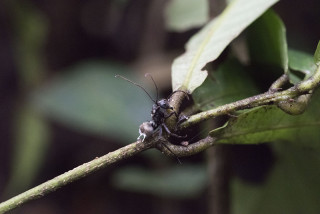
While a myriad of cordyceps species work by infecting many different animals, Ophiocordyceps unilateralis, which infects a a number of different ant species, has been most heavily researched. Ants that have contracted the fungus carry it with them for a number of hours before the zombification process begins.
“We found that infected ants behave as zombies and display predictable stereotypical behaviors of random rather than directional walking, and of repeated convulsions that make them fall down,” wrote a team of researchers from Penn State on the zombie ant phenomenon. 3
This is the first sign of infection. Once the zombie ant has fallen from its elevated path (the species of ant targeted by cordyceps rarely walk along the forest floor) it develops what other researchers have called “Summit Disease.” At this point of zombification, the ant appears to have lost all will and behaves solely at the behest of its parasite. The zombie ant climbs any nearby leaf stem and proceeds drunkenly to the main vein of the underside of the leaf. It then bites into the leaf vein in what scientists call a “death grip.” 4
This is the final act of zombification. The death grip is the last action of the living ant before its body atrophies and dies, only to become the fungus' site of reproduction. 5
Though, one might wonder, at what point does the zombie ant die? When it is no longer living, or when it stops behaving by its own will? Which might lead one to ask, do ants have free will?
I posed that very question to one of Utah’s leading researchers on ants, Dr. Jack Longino of the University of Utah. He laughed, his tone shifted a bit, and he mused.
“Basically free will is some observation of things making a decision, of looking at a situation and making a choice. You see those same kinds of decision making behaviors in ants that you see in humans.”
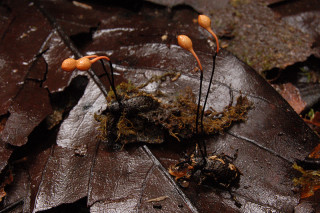
Of Zombies and People
Zombies have been a fancy of the imagination for a long time. Born of Haitian folklore, the zombie, despite different pop-cultural canons and iterations, is an animation (or reanimation) of someone (or something) dead. Though, the original zombies of Haitian folklore weren’t actually dead, but lobotomized, or brain damaged people.
“To me what the zombie is, is the loss of agency,” says Kyle Bishop, Southern Utah University Associate Professor of English.
Bishop has written several books about zombies and teaches about their historical and cultural implications at SUU. To Bishop, and to many of us who entertain the notion of zombies, the metaphor is a means for making sense of life, mortality, and mostly, of agency.
“Ultimately the zombie is a slave metaphor,” Bishop says. “It comes out of a slave culture, of a practice of enslavement. To me, that’s what is at the heart of the zombie, and what’s most interesting about the zombie. Nothing is more terrifying than losing your ability to control your own body or make your own decisions.”
Bishop then went on to explain why zombies have such impact on western culture.
“I think it resonates particularly with an American audience because our whole national identity is caught up in the idea of making our own choices. So to take a nation that was once a colony that had to fight for its independence and then threaten them with a loss of that independence, a loss of that autonomy, is really one of the most terrifying things that we can imagine, especially because we, as a nation, practiced the enslavement of others as well.”
If the metaphorical zombie can mean so much and have such historical impact, what can we learn of the real-life zombie?
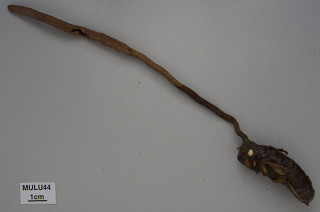
A Cure from the Dead
Cordyceps like many fungal species have long held myriad medicinal uses. Cyclosporin A, which was listed by the World Health Organization as an essential medicine, is widely used as a powerful immunosuppressant to aid organ transplants.
“Here’s the story,” said Bryn Dentinger, NHMU’s curator of mycology. “[Cyclosporin A] came from this fungus called Tolypocladium inflatum, and nobody knew really that it belonged to anything above ground like a cordyceps until somebody started sequencing DNA from a bunch of cordyceps species and, lo and behold, one of the sequences from a cordyceps that infects a beetle larva turned out to be an identical match. It turns out that Tolypocladium inflatum is just the asexual phase, the vegetative phase of the cordyceps that attacks these beetles.”
Another species of cordyceps that grows in Chinese grasslands is harvested and sold as a highly expensive panacea.
“There is real potential medicinal value in the natural products that these organisms make, primarily because they have a phase of their life cycle where they attack and take over a host,” Dentinger says. “So it isn’t too surprising then that the chemicals that they produce that allow them to do that to a beetle might also work on other animals like us.”
Zombies Near and Far
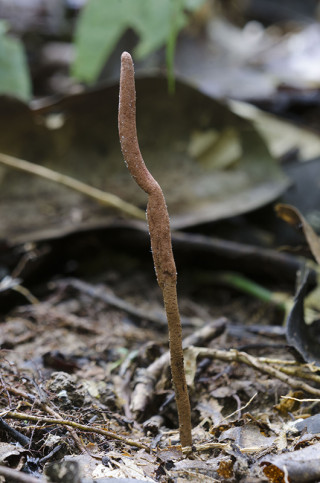
We now know of real-life zombies found in the far flung corners of the world, but what of those parasitic, zombifying forces found not so far? Right here along the Wasatch front lives a species of worm that infects orthopterans like grasshoppers and crickets to do their bidding much the same as cordyceps infects ants and spiders in the tropics.
Christy Bills, NHMU Entomology & Malacology Collections Manager suspects it was this very zombifying horsehair worm that decimated a local Jerusalem cricket population.
“I’m suspicious, though I can’t prove it,” says Bills. “For about seven years there were no Jerusalem Crickets here. I collected them one night and they were all infested. Then they all died and their were none. Just this year we started getting them again.”
Like cordyceps manipulate the behavior of infected arthropods to find beneficial reproductive sites, the Horsehair Worm, which lives primarily in small bodies of water such as streams and ponds, infects its host through the water ingested by it. Once infected, a zombified host will behave abnormally and in ways that endanger its own survival. Once the Horsehair Worm has had the opportunity to mature to reproductive age inside its host, it will manipulate its host to move near and actually fall into a body of water where it can then leave the host body and reproduce, fulfilling its life cycle. 6
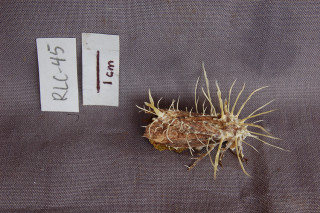
“Go to the ant thou sluggard, consider her ways and be wise…” Proverbs, 6
In researching for this post, I was overcome with questions, not of biological forces, but of humanitarian will. Do we define free will the same for humans as for that of the ant? What is it about different animals that carry certain human associations? What are the implications of scientists co-opting pop-culture concepts? Fortunate to have the time of some very busy, very intelligent professionals, I posed some of these questions. Here’s what they had to say:
On scientists co-opting pop-culture concepts:
“I think it speaks to our efforts to make science more accessible. We see a lot of push in education with stem work and stem funding in trying to get young people more invested in science, particularly young women. So, rather than pop-culture bleeding over into science, I think its science appropriating pop-culture to try to capture imagination and grab attention,. So much of the most popular pop-culture is scientifically founded, so it kind of makes sense that we’re flipping the other way.” -Kyle Bishop
On whether or not zombifying arthropods is the most horrifying act of a fungus:
“[laughs] I guess that’s pretty subjective.” -Bryn Dentinger
On why humans identify with ants:
“If you look at the history of thought about the natural world, in a creationist worldview, where everything is here to revolve around humans, which was a dominant mode of thought in the medieval period, animals were there to feed us, everything had some purpose. Some of these wild animals, their purpose was to provide moral guidance or examples of human emotions. It was common to ascribe particular aspects of the human condition. We use various animals as almost symbols of particular things. And it's always animals of local cultures, and almost all cultures do this. And they use the species that are around them. But ants are everywhere so almost every culture has noticed ants, they are such a dominant part of the environment. So, we’ve used them to represent various things. Ants have traditionally been associated with industriousness, of being good examples of having a proper work ethic.” -Jack Longino
On free will:
“Do we have free will? It’s hard to know. Does the cricket have free will? Do humans have free will? When you work your way up the chain, some people don’t even think humans have free will, and do we? I don’t know. When you see people acting aberrantly because of brain injuries it really makes you wonder. It makes you think how much of it is just physical structure and chemicals that make up who we are.” -Christy Bills
References:
1 Wojcik, D. P. (1989). Behavioral Interactions between Ants and Their Parasites. The Florida Entomologist,72(1), 43. doi:10.2307/3494966
2 Hughes, D. P., Araújo, J. M., Loreto, R. G., Quevillon, L., de Bekker, C., & Evans, H. C. (2016). From So Simple a Beginning: The Evolution of Behavioral Manipulation by Fungi. Advances In Genetics, 94437-469. doi:10.1016/bs.adgen.2016.01.004
3 Hughes, D. P., Billen, J., Boomsma, J. J., Himaman, W., Andersen, S. B., & Hywel-Jones, N. L. (2011). Behavioral mechanisms and morphological symptoms of zombie ants dying from fungal infection [electronic resource]. BMC Ecology, 11(1), 173.
4 Klein, S. L. (2003). Parasite manipulation of the proximate mechanisms that mediate social behavior in vertebrates. Physiology & Behavior, 79(3), 441-449.
5 Thomas, F., Poulin, R., & Brodeur, J. (2010). Host manipulation by parasites: a multidimensional phenomenon. Oikos,119(8), 1217-1223. doi:10.1111/j.1600-0706.2009.18077.x
6 Biron, D., Marche, L., Ponton, F., Loxdale, H., Galeotti, N., Renault, L., . . . Thomas, F. (2005). Behavioural manipulation in a grasshopper harbouring hairworm: a proteomics approach. Proceedings of the Royal Society B: Biological Sciences,272(1577), 2117-2126. doi:10.1098/rspb.2005.3213
Westin Porter is a Digital Science Writer for the Natural History Museum of Utah, a part of the University of Utah in Salt Lake City. Our mission is to illuminate the natural world and the place of humans within it. In addition to housing outstanding exhibits for the public, NHMU is a research museum. Learn more.
